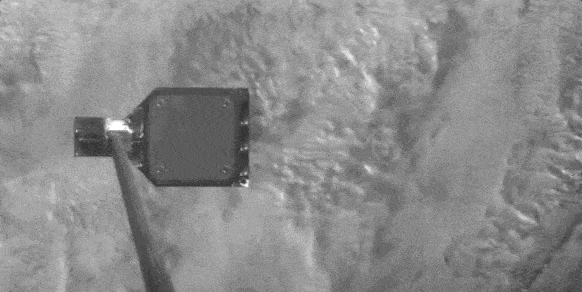Watch a Space Junk Harpoon Complete a Successful Test Shot

Space junk is a growing problem-the European Space Agency estimates that there are over 750,000 pieces of debris in space over 1 centimeter big. Considering how commercial projects like SpaceX want to increase travel beyond the planet, there's the chance that it could metastasize over the next several years.
The RemoveDEBRIS system, based out of the University of Surrey in England, has been testing a harpoon-based system of removal of since last year. RemoveDEBRIS just finished its third successful test in space.
Shot off at 20 meters/sec (approximately 44 miles per hour), the harpoon was able to successfully spear a five-meter (approximately 16-foot) wide metal plate, formerly a satellite panel, released from a main spacecraft. The harpoon was able to puncture the plate, proving the test successful.
“This is RemoveDEBRIS’ most demanding experiment and the fact that it was a success is testament to all involved. The RemoveDEBRIS project provides strong evidence of what can be achieved with the power of collaboration – pooling together the experience across industry and the research field to achieve something truly remarkable,” says Professor Guglielmo Aglietti, Director of the Surrey Space Center at the University of Surrey, in a press statement.
Previously, testing the RemoveDEBRIS system has meant checking out its fundamentals-using a net to simulate a capture, using on-board LIDAR and optical camera systems to identify space junk. This spearing represents the strongest case yet that RemoveDEBRIS can reduce space junk.
“Space debris can have serious consequences for our communications systems if it smashes into satellites," says Chris Skidmore, a British MP and and current Minister of State for Universities, Science, Research and Innovation. "This inspiring project shows that UK experts are coming up with answers for this potential problem using a harpoon, a tool people have used throughout history."
The RemoveDEBRIS system will undergo one more test after this, placing itself on the sacrificial altar of science. In March, the system will inflate a sail that will take the entire satellite into the Earth's atmosphere, where it will burn up and disintegrate.
There are several ideas on how to eliminate space junk. Another concept is an ion beam shepherd (IBS), which would never have physical contact with the debris but would use a plasma beam to push objects towards desired locations, like a planet's atmosphere.
Source: MIT Technology Review
('You Might Also Like',)
